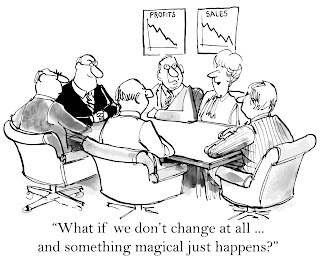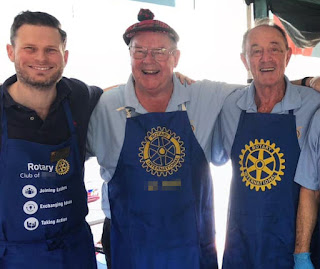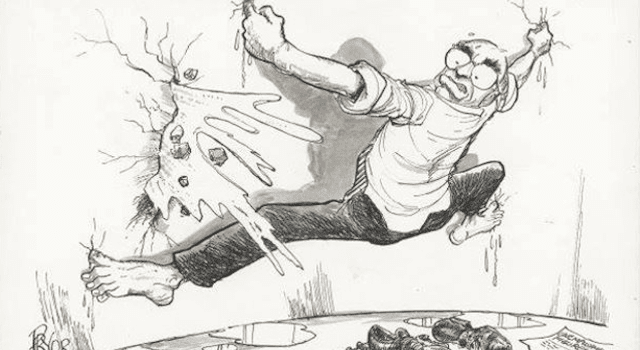It’s been close to two years since I produced my last blog about Rotary’s membership challenges. In mid 2022 I used a blog to call on Rotarians in Zone 8 to take a leap of faith and vote “YES” to our regionalisation pilot. I was part of a team of presenters that visited clubs in my own District (9510) as part of a zone wide effort to outline the benefits of the pilot. In all honesty, I thought the chances of getting the pilot up were 50/50 at best. Apathy has always been a retarding force in membership development, and I expected it would play a role in the outcome of the vote. But in the end, the vote wasn’t even close. A staggering 89% of clubs across the zone voted in the affirmative. That’s not a landslide, but an avalanche. This despite a campaign that was unavoidably lacking in detail and promoting a somewhat nebulous concept. My take on the result was that clubs were saying “anything but the current way”.
The presentation made implicit claims about improving membership outcomes, such as “enabling us to grow”, and I speculate the pilot’s success will be judged more by membership outcomes than anything else. And that’s not an unreasonable expectation. After all, why would we go to all this bother to reconfigure administrative structures across the zone if we weren’t hopeful of growth? The simple fact is we are currently haemorrhaging members, and any transfusion will be futile unless we first find a way to cauterise the wounds. What we need is Cultural Transformation, which is a gargantuan task.
These days I start my membership presentations with the following quote: “Our inability to reverse our membership decline is due not to a lack of knowledge, but a lack of will.” It’s really critical that people grasp the notion that the primary issue holding us back is resistance to change and an unwillingness to step out of the comfort zone, not an inability to find solutions. But I’m convinced that resistance is not coming from the majority. It would be foolish to suggest otherwise given the Regionalisation Pilot vote. It has been my experience that those clubs which are struggling to modernise have met with resistance not from the majority of their members, but a minority (sometimes only one) who hold disproportionate influence. I often refer to this group as the Guardians of the Status Quo. To put it another way, the biggest challenge facing those Rotarians who hold genuine concerns about their club’s trajectory is not in finding solutions, but in finding ways to implement them.
So what exactly is Cultural Transformation? The simplest definition Google found me was this one:
Cultural transformation is a process of changing the values, norms, and beliefs that shape an organisation's behaviour and decision-making.
I suggested earlier that we have a gargantuan transformative task ahead of us, but Rotary has actually been undergoing cultural transformation for as long as I can remember, albeit at a somewhat glacial pace. I have identified eight key areas to investigate, and will provide some commentary and a star rating out of five to express where I feel we currently find ourselves in Zone 8 on those transformational journeys. One star means we have barely begun and 5 stars means the transformation process is complete. Nothing gets 5 stars! I appreciate this is very subjective, and I’m trying my best to give an overall picture based on my interactions across the zone, but I’m well aware that many individual clubs will not align with my ratings.
Our Transformation from a Male Culture to a Uni-sex Culture - ★★★½
For the first 84 years of our history we were a male only organisation. I wasn’t a Rotarian when the rules were changed in 1989, but I was a Rotaractor with a close connection to a sponsoring Rotary club, and was able to watch that club’s reaction at an arm’s length. Like many clubs, it took a number of voting attempts before finally accepting women into the club, and a few members left as a result. We’re now 35 years downstream from that decision, and there is no doubt in my mind that the inclusion of women has facilitated the greatest cultural transformation that Rotary has ever seen, or will ever likely see. Gender parity is still a way off I suspect, for two reasons; firstly, the men did have an 84 year head start. Secondly, sadly, there are still clubs which either don’t accept or don’t welcome female members. There are regions of the world where this is due to cultural reasons. I’m not one who accepts that as an excuse.
Females currently account for 31% of our membership base across the zone, and for the last 15 years or so, 50% of our inductees have been female. The emergence of newer, more flexible and family friendly clubs has most certainly proven more attractive to females. My own club, the Rotary Club of Seaford, which chartered in 2016 has remained two thirds female. We’ve made amazing inroads, and no-one can credibly suggest that Rotary is not better off since females joined our ranks. But until females feel welcome, appreciated and comfortable in every club, we still have work to do.
... from an Exclusive Culture to an Inclusive Culture - ★★★★
... from a Covert Culture to an Overt Culture - ★★½
I’d stop short of suggesting that Rotary ever deliberately set out to be secretive, but for many years our light remained hidden under the bushel because we historically hadn’t made much effort to tell our story. I recently used some dryish humour in one of my presentations where I asked, “What is the difference between cooking sausages and eradicating polio?” The answer; the general public can draw a link between Rotary and cooking sausages.
The bottom line is, if the general public has at times seen us as a secret society, that’s our fault, not theirs. These transformative journeys need to account for perceptions, not just realities, and we must make greater strides in communicating our narratives about who we are, what we stand for, what we do and the benefits of membership.
... from a Rigid Culture to a Flexible Culture - ★★★
It became very apparent to me when I first took up the role of District Membership Chair in 2014 that flexibility was what we were crying out for. I can remember in my earliest days of Rotary in the late 90s a very rigid culture full of rules and traditions. I feel we’ve been obsessed with process for many years to the detriment of outcomes. The staggering list of rituals observed at meetings included fines, songs, prayers, toasts, head tables, bell ringing, presidential collars and other trappings of office, strange looking boxes getting passed around for loose change, banners, raffles, and unwritten rules about who could sit in which chair. Clubs have always been autonomous, and able to self determine which customs worked for them and which didn’t. Of course every three years we hold our Council on Legislation to consider proposals to change our rules. This is a monumental, and very expensive festival of process, but it did deliver some extraordinary measures in flexibility back in 2016. The greatest cultural transformation from rigidity to flexibility I’ve seen in my time in Rotary came with the removal of the weekly meeting requirement. Corporate membership options were officially introduced at that council too, together with a raft of different club formats including satellite clubs, cause based clubs, and passport clubs. Eclubs had also been introduced in the early 2000s. We used to be very rigid about membership eligibility and classifications too. Despite RI’s interest in tinkering with different membership options, the bottom line is that RI membership is binary. You’re either a due paying member, or you’re not. Direct membership is currently being trialled in the UK, where one joins Rotary directly, rather than being a member of a specific club. So, I’ve got to give a big tick to our record of cultural transformation in the field of flexibility.
But flexibility at club level does not necessarily mean changing our constitution. Flexibility can be as simple as allowing members to pay their member fees in instalments, attend a meeting without purchasing a meal, bringing their young children along or joining the meeting online when they cannot attend in person. There are of course some clubs around the place that are still quite rigid with their rules and expectations on members, but I genuinely feel RI leadership has done a great job in enabling and promoting more flexible versions of Rotary.
... from a Culture of Member Attendance to a Culture of Member Engagement - ★★★
Attendance rules have softened somewhat over the years, but there is still considerable pressure placed on Rotarians to attend meetings. That pressure can be overbearing at times. I know of a story not long ago where a group of young people were attracted to a club by the promise of international service opportunities. They quickly became very busy coordinating major humanitarian projects, but eventually left the organisation because of the continual badgering about their poor meeting attendance. They weren’t seen as “good Rotarians”. Conversely, we have many members amongst us who contribute little more from a volunteering perspective than the occasional turning of sausages, but because they religiously attend every meeting they are upheld as exemplary members.
My personal approach is that I like to see members turning up to meetings, but I prefer to ask the question, “How are they contributing to the club?” RI leaders started talking about valuing member engagement over member attendance in the mid 2000s. I don’t know if any clubs still have attendance officers, and I haven’t heard the term “make-up” in Rotary circles for many years, but it is still possible for a member to be terminated after failing to attend four meetings in a row. The bottom line is we need to find ways to engage members over and above attending meetings.
... from a Culture of Business Leaders to a Culture of Business and Community Leaders - ★★★★½
... from a Formal Culture to an Informal Culture - ★★★★
The list of Rotary traditions, rituals and formalities observed primarily in meetings is considerably shorter on average than it was 20 years ago. I expect Rotary culture is following a general societal trend towards informality. I wore a collared shirt and tie to most of the meetings I attended for my first 10 years as a Rotarian (1997-2007), but over the last 10 years it has been very rare indeed that I have worn a tie, except maybe to a district dinner and on occasions when I am presenting. I can recall the Sergeant-at-arms fining Rotarians for not wearing their lapel pins to meetings, and I keep hearing calls for Rotarians to wear their lapel pins in public. Most of the time I’m in public, I don’t even have a collar on my shirt.
I’m of the opinion that a certain level of formality is necessary to keep clubs functioning effectively and we can’t let every baby out with the bathwater. But we mustn't conflate the formalities of basic governance, ethics, courtesy and respect with ritualistic activities that no longer serve a purpose, and can act as a repellent to membership. The toasting, the invocations, the singing, the fining, the head tables, the presidential collars; they’re all disappearing from Rotary life.
... from a Meeting Centric Culture to a Service Centric Culture - ★
I won’t beat around the bush with this issue. I have felt for a long time that we have an unhealthy obsession with meetings. We often tend to venerate the meeting as the epitome of Rotary life, and until we manage to refocus our energies and prioritise service, we will never reverse our membership decline.
Most of our barriers to membership are inextricably linked to our meeting culture. Numerous RI surveys have revealed that the top two reasons given for not joining Rotary are time and financial demands. Without doubt the greatest drain on a Rotarian’s time throughout their Rotary journey is club meetings, and the greatest involuntary drain on a Rotarian’s finances is not member fees, but meeting costs such as meals, drinks, raffles, fines, etc. Throw in the potential for uninspiring speakers, daggy rituals, ordinary food/service/venues, and inappropriate fines, and you have the perfect member repelling storm.
I’m well aware that our regular meetings are a highlight for an enormous segment of our membership base. They value the camaraderie and entertainment aspect of meeting culture and will fight against any threats to it. But we also need to understand the realities of our current demographics. In Zone 8 our average age is over 72, close to 85% of us are over 60 and we have more retirees than full time workers. We’ve experienced a net loss of 10,000 members over the last 10 years and 73 clubs have handed in their charter since July 2020. The demographic which is so attached to meeting culture is the same demographic we’re losing.
There is no doubt that many clubs still run excellent meetings in excellent venues with an excellent speaker program. But we need to look to the future and realise that our meeting centric value proposition simply won’t attract the vast majority of community minded volunteers looking for something to be a part of. I'm not saying that there is no place for meetings in Rotary, I'm simply saying we need to find other ways to engage our volunteers and facilitate impact in our communities. The longer we position meetings at the centre of the Rotary universe, the longer it will take to reverse our decline.
There are other transformations required...
Of course I'd like to see a transformation in our age profile. Whilst approximately 50% of the population is aged under 50, only 8% of Rotary's membership in Zone 8 is under 50. There are of course initiatives individual clubs can implement to become more attractive to a younger audience, but if we want to see a zone wide reduction in our age profile, we need to ramp up our zone wide cultural transformation efforts. By my analysis, the highest priorities should be in the areas of overtness, flexibility, member engagement and meeting fixation, which I have given a lower star rating above. These are elements of Rotary culture which we can directly control. Our age profile is not one of them. It can only change as a consequence of cultural transformation.
I'd also like our clubs to become more proactive than reactive. It's wonderful that clubs are responsive to needs in their communities, but I'd like to see Rotary taking the lead in building more fences at the top of the cliff, rather than sponsoring the ambulances at the bottom. Some clubs seem to be locked into a cycle of "cook sausages to raise funds, hold meeting to hear guest speaker, hand over cheque to guest speaker, repeat." I'd rather see more leadership and direction with the causes we support, rather than being a soft touch for external causes who could be cooking their own sausages.













.jpg)










